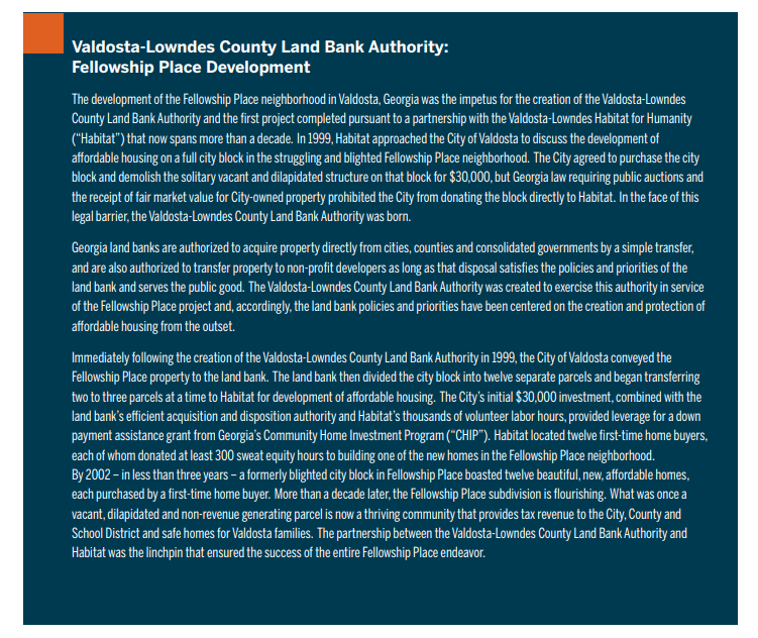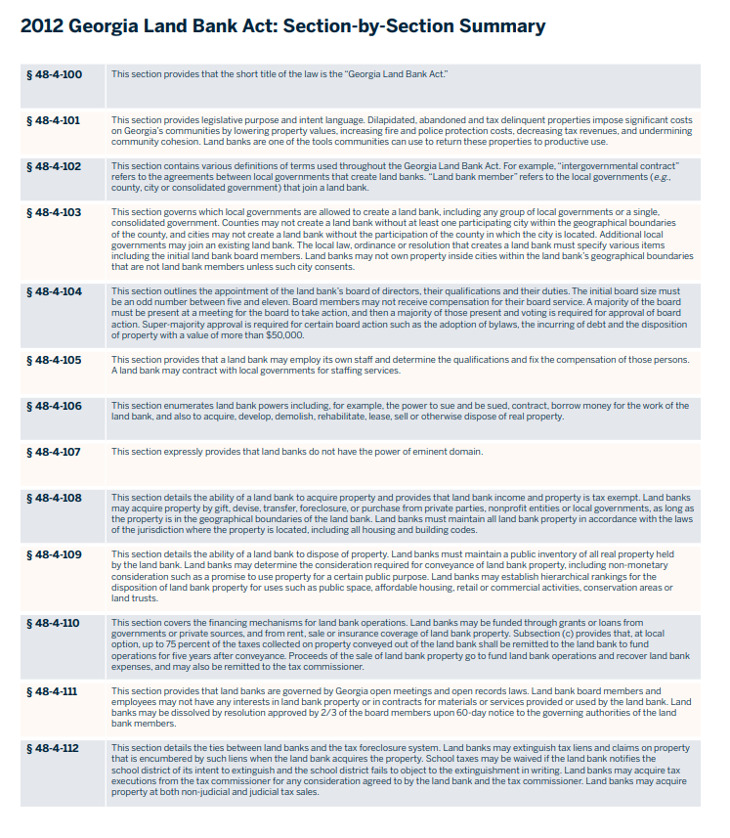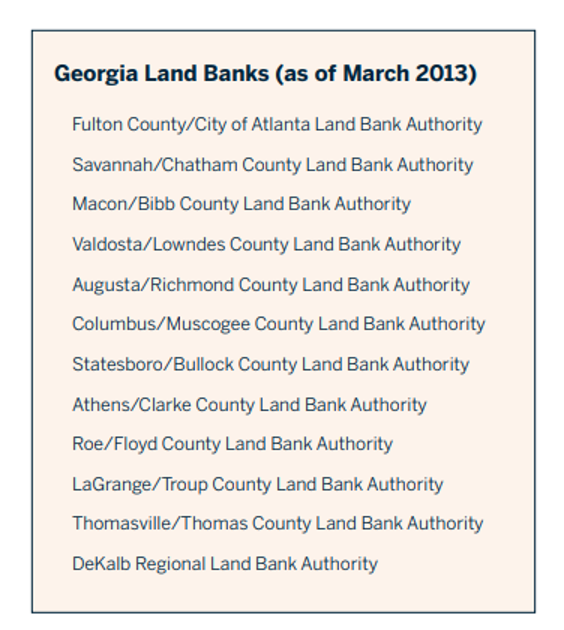Georgia Land Bank Resource Manual

The Georgia Land Bank Resource Manual was prepared to assist existing and newly anticipated Georgia land banks take advantage of the 2012 Georgia Land Bank Act, and to provide template creation documents, land bank directories, and other Georgia land bank resources all in one free and easily accessible publication.
Challenge
The adoption of the 2012 Georgia Land Bank Act paved the way for existing GA land banks to opt in and obtain the new and expanded powers authorized under the Act, and for new land banks to proliferate throughout Georgia. Limited resources for legal and technical assistance and lack of familiarity/capacity to utilize GA land banking law are an endemic challenge and present barriers to communities that most need a land bank. Local government attorneys and stakeholders in many of Georgia’s 159 counties have little or no experience with land banking and the related law and policy systems, let alone the capacity to stand up a new and entrepreneurial technical public authority.
Solution
CCP Senior Fellows Frank S. Alexander and Sara Toering, in partnership with Valdosta/Lowndes County Habitat and HUD, drafted and published this Manual to provide land banking background and explanatory information, key statutes and statutory summaries, and template creation and operation documents in one easily accessible FREE location. Local government leaders and non-profit leaders/stakeholders can go to this free resource to find everything they need to know to get started on land banking in Georgia. Directories of Georgia land banks and Habitat affiliates are also provided in the Manual so that stakeholders can locate and consult with existing Georgia land bank leaders and partners.
- Chapter 1 tells the story of the first two decades of land banks and land banking in the State of Georgia, including the initial triggers for land banking, key early successes and lessons learned. Chapter 2 describes the impetus for the creation of the Georgia Association of Land Bank Authorities (“GALBA”) and outlines key aspects of the 2012 Georgia Land Bank Act that were developed and championed by GALBA including a) the ability to create regional land banks comprised of multiple counties and cities, b) the ability for local land banks to adopt and pursue various self-financing mechanisms including tax recapture programs, and c) the ability to develop and adopt priorities for land bank property acquisition, maintenance and disposition at the local level. Chapter 3 provides an overview of the creation process for land banks under the 2012 Georgia Land Bank Act, including board structure, identity and responsibilities, and also describes the tax recapture program authorized by the 2012 Georgia Land Bank Act. Chapter 4 outlines key considerations for land bank powers and operations, including property acquisition, maintenance and disposition.
- Success stories from various land banks are provided throughout for inspiration and examples.
- Appendices include the 1990 GA land bank statute, and the 2012 Georgia Land Bank Act.
- Appendices include template documents for land bank creation and initial operations including sample local government creating resolutions, sample policies and procedures and tax extinguishment resolutions.
- Appendices include a directory of both Georgia Land Banks and Georgia Habitat for Humanity affiliates.
Impact
The Georgia Land Bank Resource Manual is sometimes colloquially referred to as the Georgia Land Bank Bible—a hard copy is in the hands of almost every land bank leader in the state. The number of Georgia land banks has more than doubled since publication of the Manual, and the majority of creation and governing documents utilized throughout the state are drawn directly from the free Manual—helping to both establish a baseline of practice for land banks throughout Georgia, and saving thousands of professional hours and dollars that would otherwise be required to prepare such documents in the absence of templates. In addition, publication and wide distribution and use of the Manual paved the way for ongoing collaboration and free sharing of best practices among the Georgia Land Bank community, and ultimately served as a model for publication of the 2022 Resource Guide for Georgia Land Banks, designed to serve Georgia land banks at a more sophisticated level of development, and to share best sample documents reflecting innovative and best practices throughout the Georgia land bank network.



Topic(s): Code Enforcement System, Land Banks, Local Analysis, Parcel Data & Neighborhood Markets, Property Tax System, Racial Equity, State/National Analysis
Published: June, 2025
Geography: Georgia
Services: Build Capacity: Best practices and field informing publication
Client: Valdosta-Lowndes Habitat for Humanity and HUD (section 4 Grant)
Partners: The Georgia Land Bank Resource Manual is a publication of the Valdosta-Lowndes County Habitat for Humanity and the Department of Housing and Urban Development. Additional co-sponsors including the Georgia Association of Land Bank Authorities, Enterprise Community Partners, Georgia Municipal Association, Association County Commissioners of Georgia and the Center for Community Progress.
Interested in these services for your community? We can help! Contact the Technical Assistance Team »
Get the latest tools, resources, and educational opportunities to help you end systemic vacancy, delivered to your inbox.
